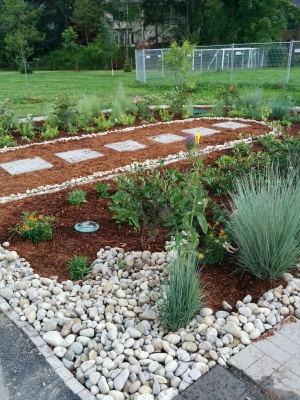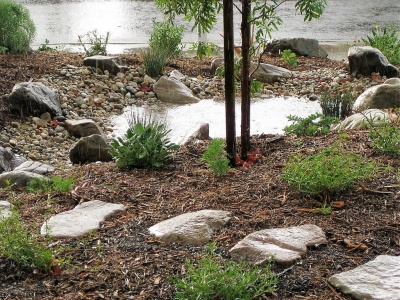Difference between revisions of "Stone"
Kyle menken (talk | contribs) m |
Dean Young (talk | contribs) |
||
| (30 intermediate revisions by 4 users not shown) | |||
| Line 1: | Line 1: | ||
| − | [[File: | + | [[File: Kenollie Rain Garden.jpeg|thumb|This rain garden in a school yard uses stone as both decorative edging and for erosion control.]] |
| − | [[File: IMAX_Stone_Inlet. | + | [[File: IMAX_Stone_Inlet.jpeg|thumb|This bioswale in a parking lot uses stone at the inlets and along the bottom of the swale to prevent erosion, as the sides are sloped.]] |
| + | For advice on aggregates used in [[Underdrains|underdrains]], see [[Reservoir aggregate]]. | ||
| − | + | Stone or gravel can serve as a low maintenance decorative feature, but it may also serve many practical functions on the surface of an LID practice. | |
| − | + | ===Stone for erosion control=== | |
| − | Stone can serve as a low maintenance decorative feature, but it may also serve practical functions | + | Aggregates used to line [[swales]] or otherwise dissipate energy (e.g. in [[forebays]]) should have high angularity to increase the permissible shear stress applied by the flow of water. <ref>Roger T. Kilgore and George K. Cotton, (2005) Design of Roadside Channels with Flexible Linings Hydraulic Engineering Circular Number 15, Third Edition https://www.fhwa.dot.gov/engineering/hydraulics/pubs/05114/05114.pdf</ref> However, in some surface landscaped applications there may be a desire to use a rounded aggregate such as 'river rock' for aesthetic reasons. Rounded stones should be of sufficient size to resist being moved by the flow of water. Typical stone for this purpose ranges between 50 mm and 250 mm in diameter. The larger the stone, the more energy dissipation. |
| − | |||
| − | |||
| − | |||
| − | |||
| − | |||
*Stone beds should be twice as thick as the largest stone's diameter. | *Stone beds should be twice as thick as the largest stone's diameter. | ||
| − | * | + | *If the stone bed is underlain by a drainage [[Geotextiles|geotextile]], annual inspection and possible replacement should be performed as there is a potential for [[clogging]] of this layer to occur. |
| − | + | {{:Stone: Gallery}} | |
| − | |||
| − | |||
| + | ===Stone mulch=== | ||
| + | Finer inorganic mulch materials can be of value applied in areas with extended ponding times i.e. in the the centre of recessed, bowl shaped [[bioretention]], [[stormwater planters]], [[trenches]] or [[swale]] practices. Inorganic mulches resist movement from flowing water and do not float. Applying a thin layer of inorganic mulch over the top of wood based mulch has been shown to reduce migration of the underlying layer by around 25% <ref>Simcock, R and Dando, J. 2013. Mulch specification for stormwater bioretention devices. Prepared by Landcare Research New Zealand Ltd for Auckland Council. Auckland Council technical report, TR2013/056 </ref>. | ||
| + | Inorganic mulches which may be available locally, include: | ||
| + | *Pea gravel | ||
| + | *River rock/beach stone | ||
| + | *Recycled glass | ||
| + | *Crushed mussel shells | ||
| + | ---- | ||
[[Category:Materials]] | [[Category:Materials]] | ||
| − | |||
[[Category:Landscaping]] | [[Category:Landscaping]] | ||
Latest revision as of 15:05, 15 July 2020
For advice on aggregates used in underdrains, see Reservoir aggregate.
Stone or gravel can serve as a low maintenance decorative feature, but it may also serve many practical functions on the surface of an LID practice.
Stone for erosion control[edit]
Aggregates used to line swales or otherwise dissipate energy (e.g. in forebays) should have high angularity to increase the permissible shear stress applied by the flow of water. [1] However, in some surface landscaped applications there may be a desire to use a rounded aggregate such as 'river rock' for aesthetic reasons. Rounded stones should be of sufficient size to resist being moved by the flow of water. Typical stone for this purpose ranges between 50 mm and 250 mm in diameter. The larger the stone, the more energy dissipation.
- Stone beds should be twice as thick as the largest stone's diameter.
- If the stone bed is underlain by a drainage geotextile, annual inspection and possible replacement should be performed as there is a potential for clogging of this layer to occur.
Stone lining the ponding zone of this rain garden. Image credit California Native Plant Society
Coarse angular stone laid onto a geogrid and geotextile. Image from wikimedia commons
Stone mulch[edit]
Finer inorganic mulch materials can be of value applied in areas with extended ponding times i.e. in the the centre of recessed, bowl shaped bioretention, stormwater planters, trenches or swale practices. Inorganic mulches resist movement from flowing water and do not float. Applying a thin layer of inorganic mulch over the top of wood based mulch has been shown to reduce migration of the underlying layer by around 25% [2]. Inorganic mulches which may be available locally, include:
- Pea gravel
- River rock/beach stone
- Recycled glass
- Crushed mussel shells
- ↑ Roger T. Kilgore and George K. Cotton, (2005) Design of Roadside Channels with Flexible Linings Hydraulic Engineering Circular Number 15, Third Edition https://www.fhwa.dot.gov/engineering/hydraulics/pubs/05114/05114.pdf
- ↑ Simcock, R and Dando, J. 2013. Mulch specification for stormwater bioretention devices. Prepared by Landcare Research New Zealand Ltd for Auckland Council. Auckland Council technical report, TR2013/056



